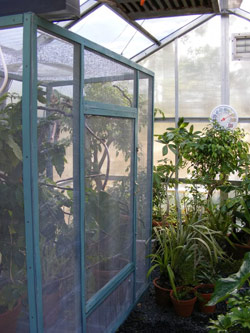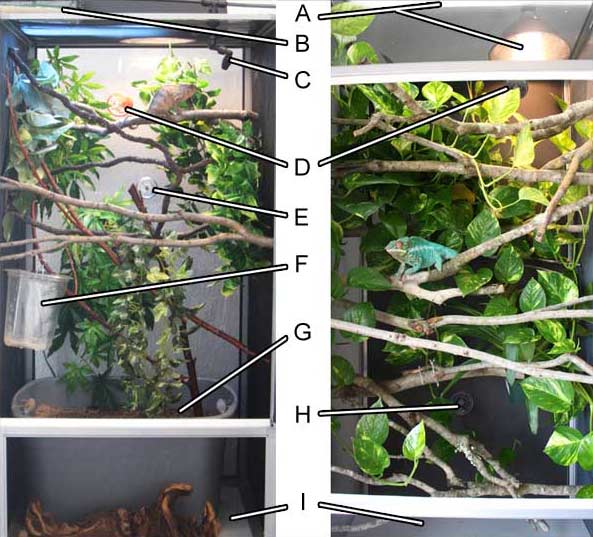Follow along with the video below to see how to install our site as a web app on your home screen.
Note: This feature may not be available in some browsers.
You should upgrade or use an alternative browser.
Chameleon Enclosures

While there are many different methods for keeping chameleons these general guidelines can be applied successfully to most species.
- Chameleons need a cage that is taller than it is wide so they can climb vertically.
- Ideally the top branch in the cage should be above your eye level. You may need to add a stand or a table to achieve proper cage height.
- The most common mistake people make is getting a cage that is too small. Most chameleon species will need a cage that is at least 24"x24"x48" (61cm x 61cm x 122cm) tall. See species caresheets for specific requirements.
- Every chameleon should have one linear UVB light the width of the cage top and one basking light of appropriate wattage. All lights should be on top and outside of the cage shining downwards.
- The top of the cage must be screen because UVB rays will not penetrate glass or plastic.
- There should only be ONE chameleon per cage. Think of chameleons like Betta Fish - they are beautiful but they cannot live with others.
- Screen cages, and hybrid cages with a mix of screen and solid sides, are popular because they have better ventilation, are readily available and are less expensive than all glass cages of the same size. Your geographic location and ambient humidity levels may affect your cage type choice.
- Beware the Exoterra glass cages – these cages are often suggested by petstores for your new chameleon. They are good starter cages for babies, but they are often far too small to use for Veiled, Panther and Jackson chameleons over 6 months old.

- Chameleons need lots of leaves to hide behind and lots of vines or branches to climb on. More leaves will make your chameleon feel safe, which will actually make them come out where you can see them better.
- Both real and fake plants can be used in your chameleon cage. Live plants are preferable. Real plants help to increase and maintain humidity, are better at holding water droplets for drinking and are safer in case your chameleon eats them.
- Use only non-toxic plants in your cage since chameleons or their feeder bugs could eat them. Some commonly used plants: Schefflera arboricola, Ficus benjamina, Pothos and Hibiscus. See link for more - Plants For Chameleons.
- Store-bought plants have fertilizer and insecticides in the soil that are unsafe for your chameleon. Repot the top ½ of the soil with organic soil and cover any soil with large rocks or screen because your chameleon could ingest soil causing impactions. Wash all the leaves first to rinse off chemical residues.
- If you use fake plants wash them well with soap and water first to remove any chemical residue that could be harmful.
- Clean branches from outside trees can be used in your cage. Wash well or bake branches before use. Bendy vines are available at petstores and work great in cages! Select branches or vines with a variety of widths that correspond to the grip size of your chameleon.
- Small wire can be threaded through the screen to secure vines and branches in place. Dowels can be used for perches, and thumb tacks/push pins can secure them on the ends from outside through the screen. People have also used twisty ties, fishing line, hot glue and garbage bag ties. Get creative!
- You want to arrange branches, plants and vines to utilize all the major spaces of the cage. The top zone is for basking and the middle and lower zones are used for cooling off, hunting, resting, etc.

- - One linear UVB light the width of the cage top and one basking light - All light bulbs of any kind should be placed on top of the cage pointing downwards.
- - A dripper is placed on the top of the cage so it drips onto the leaves in the cage for drinking.
- - Automatic Misting System (optional but recommended)
- - One thermometer should be placed at the same level as the branch your chameleon basks from to monitor the hottest point.
- - The hygrometer is placed anywhere in the cage to measure humidity.
- - Feeding cup (optional)
- - Egg laying bin containing appropriate substrate. (females only)
- - Another thermometer should be placed in the lower portion of the cage to monitor the change in the temperature gradient.
- - No substrate - Substrate (mulch, dirt, sand, etc.) should not be used in standard chameleon cages. Substrate can actually be harmful by allowing bacteria and mold to grow; it can also cause impaction when accidentally ingested. Only females need a laying bin containing substrate.

Waterfall - Reptile (or any small) waterfalls do not have filters so they grow mold and bacteria very quickly and are not safe for drinking. Drippers and misting only should be used for chameleon drinking.
Water bowl - Chameleons do not and should not drink from standing water sources. Bacterial growth is fast and they could potentially drown. In the wild they drink the dew and rain drops on the leaves of trees. You need to simulate this with a dripper or heavy misting so that water droplets accumulate on the leaves of the plants in their cage.
Heat rocks or pads - Unlike ground dwelling lizards, chameleons do not seek a warm rock to bask on. They are strictly arboreal (tree-dwelling) reptiles and seek out sun from above to bask in. Ground heat sources can burn their feet and belly easily and should not be used at all.
Fish tank aquarium - Horizontal cages are not appropriate for chameleons as they are arboreal (tree dwelling) animals and need vertical space to move throughout the temperature gradient. Fish tanks do not provide the vertical space or ventilation needed.
Lightbulbs inside cage - Chameleons are very good climbers and always find a way to crawl onto the light bulb or light fixture, even when you think it’s safe. Severe, life-threatening burns occur this way.
- Chameleon Forums Plant List- Plant Link
- Melissa Kaplan's Edible Plant List - Plant Link
